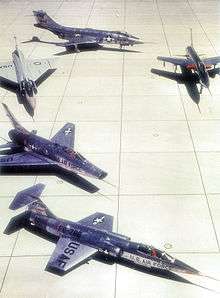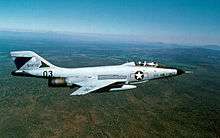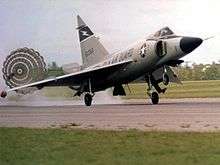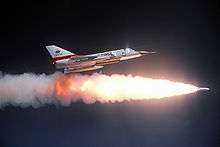Century Series

The Century Series is a popular name for a group of US fighter aircraft representing models designated between F-100 and F-106 which went into full production. They included the first successful supersonic aircraft designs in the United States Air Force's service, which remained in active service well into the 1970s and 1980s with the Air Force Reserve and Air National Guard. Three later variants, the QF-100, QF-102 and QF-106, also continued in service, primarily as aerial target drones, until the late 1990s.
Century Series aircraft
The name "Century Series" stems from the fighter (F-) designation number being in the 100-109 range. The term became popular to refer to a group of generally similar designs of the 1950s and early 1960s.
As it evolved, the attribution of the Century Series moniker reflects models designated between F-100 and F-106 which went into full production:
- North American F-100 Super Sabre
- McDonnell F-101 Voodoo
- Convair F-102 Delta Dagger
- Lockheed F-104 Starfighter
- Republic F-105 Thunderchief
- Convair F-106 Delta Dart
The term "Century Fighters" does not include less successful models between the F-100 and F-109 that did not go past design or prototype stage: the Republic XF-103 Thunderwarrior interceptor concept, the North American YF-107 and XF-108 Rapier prototypes, and F-109 originally assigned to the F-101B Voodoo and later requested but not granted for the Bell XF-109 VTOL concept.
The F- series number sequence used in USAF was a continuance of the pre-USAF pursuit aircraft (P- series) numbering, stretching back as far as to the 1920s. The numbering would continue sequentially up to the F-111, and after this number the 1962 United States Tri-Service aircraft designation system restarted the numbering[1] back from 1. Notably, the fighter-bomber briefly known as the F-110 Spectre was renamed F-4 Phantom II. The only exception is the F-117 Nighthawk stealth fighter, which was developed in secret during the late 70s and 80s.
Characteristics
The Century Series aircraft represented a mix of fighter-bombers (F-100, F-101A, F-105) and interceptors (F-101B, F-102, F-104, F-106).
The unifying characteristic of the Century Series aircraft was advanced performance and avionics when they were introduced. The F-100 was the first aircraft in the USAF capable of exceeding the speed of sound in level flight. The F-101 was the first aircraft in the USAF capable of exceeding 1,000 mph (1,600 km/h). The F-102 was the first aircraft in the world to utilize area rule in its design. Three of the Century Series aircraft — F-101, F-102, and F-106 — were armed with nuclear air-to-air missiles. These weapons, designed to destroy incoming nuclear-armed Soviet bombers even when not scoring a clear hit (due to the nuclear explosion radius, shock wave and radiation burst), were the only nuclear weapons in USAF arsenal at the time to be under sole control of their pilots (during a mission).
Similar advancements were made in this period by the United States Navy and United States Marine Corps with the F4D Skyray, F8U Crusader and F4H Phantom II carrier-based aircraft, but Naval Aviation lacked a similar naming group.
 USAF "Thunderbirds" F-100D
USAF "Thunderbirds" F-100D McDonnell F-101B Voodoo
McDonnell F-101B Voodoo F-102 deploys braking parachute
F-102 deploys braking parachute Lockheed F-104G Starfighter with external wingtip fuel tanks
Lockheed F-104G Starfighter with external wingtip fuel tanks_in_flight_with_full_bomb_load_060901-F-1234S-013.jpg) Republic F-105D with full bomb load.
Republic F-105D with full bomb load. A USAF F-106A Delta Dart fires the AIR-2 Genie nuclear rocket
A USAF F-106A Delta Dart fires the AIR-2 Genie nuclear rocket
See also
- Teen Series
- United States military aircraft designation systems
- List of military aircraft of the United States
References
| Wikimedia Commons has media related to Century Series. |
Notes
- ↑ Drendel, 1980. p.3.
Bibliography
- Drendel, Lou. Century Series. 1980. Carrolton, Texas. Squadron/Signal Publications, Inc. ISBN 0-89747-097-4